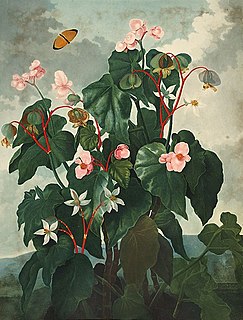
Begonia is a genus of perennial flowering plants in the family Begoniaceae. The genus contains more than 1,800 different plant species. The Begonias are native to moist subtropical and tropical climates. Some species are commonly grown indoors as ornamental houseplants in cooler climates. In cooler climates some species are cultivated outside in summertime for their bright colorful flowers, which have sepals but no petals.
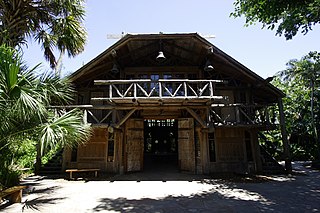
The McKee Botanical Garden is a non-profit, subtropical botanical garden in Vero Beach, Florida. It is located at 350 U.S. Highway 1, Vero Beach, Florida. It was founded in 1929, when Waldo Sexton and Arthur G. McKee purchased an 80-acre (32 ha) tropical hammock along the Indian River. Tropical landscape architect William Lyman Phillips was hired to design its streams, ponds, and trails. Its indigenous vegetation was augmented with ornamental plants and seeds from around the world. In 1932, they proceeded to open the garden, then known as McKee Jungle Gardens, as a tourist attraction. Although the Garden was successful for several decades, it shut down in 1976, and most of its land was sold for development. The site remained vacant for twenty years until the Indian River Land Trust purchased it in 1995. The current Garden was formally dedicated in 2001. It is now a Florida landmark and on January 7, 1998, it was added to the U.S. National Register of Historic Places under its former name of McKee Jungle Gardens. Currently, there are several buildings on the garden including the office, gift shop, education center and a restaurant.
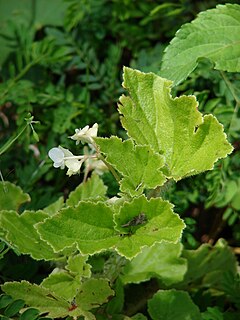
Begoniaceae is a family of flowering plants with two genera and about 1825 species occurring in the subtropics and tropics of both the New World and Old World. All but one of the species are in the genus Begonia. There have been many recent discoveries of species in the genus Begonia, such as Begonia truncatifolia which is endemic to San Vincente, Palawan. B. truncatifolia is smaller in size than other species of the genus Begonia and this new species is proposed Critically Endangered by standards set by the IUCN. The only other genus in the family, Hillebrandia, is endemic to the Hawaiian Islands and has a single species. Phylogenetic work supports Hillebrandia as the sister taxon to the rest of the family. The genus Symbegonia was reduced to a section of Begonia in 2003, as molecular phylogenies had shown it to be derived from within that genus. Members of the genus Begonia are well-known and popular houseplants.
Scutellaria sarmentosa is a species of flowering plant in the family Lamiaceae. It is found only in Ecuador. Its natural habitat is subtropical or tropical moist montane forests.
Azima sarmentosa is a species of plant in the Salvadoraceae family. It is found in Cambodia, Malaysia, Myanmar, the Philippines, and Vietnam.
Begonia eiromischa, commonly known as woolly-stalked begonia, is a presumed extinct plant from Malaysia.

Begonia grandis, the hardy begonia, is a species of flowering plant in the family Begoniaceae. This herbaceous perennial has alternate, simple leaves on arching stems. The flowers are pink or white, borne in dichotomously branching cymes from late summer through fall in USDA U.S. Hardiness Zone 7. As the common name "hardy begonia" implies, it is winter hardy in some temperate regions.
Gloria Amparo Galeano Garcés was a Colombian botanist and agronomist specializing in the palm family. Galeano was a faculty member at the National University of Colombia, and was the director of the Institute of Natural Sciences from 2003 to 2006. She received her Ph.D. from the University of Aarhus, Denmark in 1997.
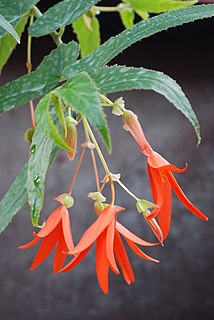
Begonia boliviensis is a plant in the begonia family, Begoniaceae, which was introduced to Europe in 1864 by Richard Pearce who discovered it in the Bolivian Andes, although the plant had previously been identified by Hugh Weddell in the same region but not introduced.

Tetracera is a genus of flowering plants of the Dilleniaceae family.

Launaea sarmentosa is a perennial herb species in the family Asteraceae. It is native to coastal areas in Africa, Madagascar, the Seychelles, Mauritius, India, Sri Lanka, Maldives and Southeast Asia. It is naturalized in Western Australia.
Schiedea sarmentosa is a rare species of flowering plant in the family Caryophyllaceae known by the common name cliff schiedea. It is endemic to Hawaii, where it is known only from the island of Molokai. It is threatened by the degradation and destruction of its habitat. It is a federally listed endangered species of the United States.
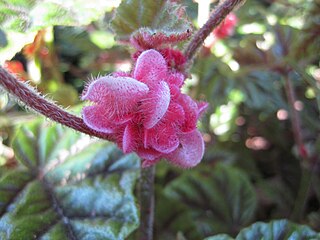
Begonia incarnata is a species of plant in the family Begoniaceae, native to Brazil. It is a shrublike evergreen perennial growing to 1 metre (39 in), bearing large, asymmetrical green leaves with a metallic sheen, and dark green veins. It produces small hairy pink flowers. As it does not tolerate temperatures below 10 °C (50 °F), in temperate regions it must be grown under glass.
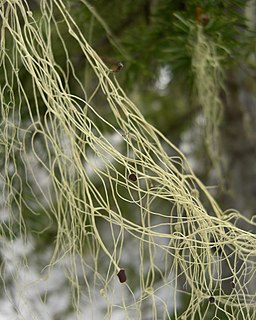
Alectoria sarmentosa is a long-lived, perennial lichen. It is also sometimes classified as a fungus. It is a light greenish colored and fruticose or bushy bodied. This epiphytic lichen belonging to the Alectoriaceae family and the suborder Lecanorineae, which includes six similar species. A. sarmentosa grows draped or strung over conifer tree limbs and deciduous shrub branches in Northern temperate rainforest. This lichen favors mature and old growth, wet conifer and hardwood forests with clean air. A. sarmentosa is sensitive to air pollution and used for air quality monitoring. Areas required by A. sarmentosa are found in northern and southern temperate zones and receive high rainfall. This lichen is commonly found in transitional areas between valley and mountainous forests, but usually avoiding the immediate coast.
Pegia is a genus of plants in the subfamily Spondiadoideae of the cashew and sumac family Anacardiaceae.

Begonia aconitifolia is a species of plant in the family Begoniaceae, endemic to Brazil. It grows up to 1 meter in height, with panicles of pink flowers.
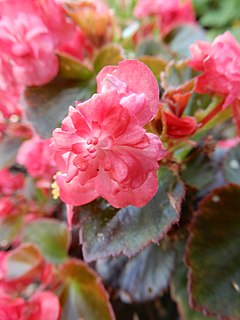
Begonia cucullata, also known as wax begonia and clubed begonia, is a species of the Begoniaceae that is native to South American countries of Argentina, Brazil, Paraguay, and Uruguay. A common garden plant and part of the section Begonia, it was described in 1805 by Carl Ludwig Willdenow (1765–1812). The specific epithet "cucullata" means "resembling a hood" or "hooded".

Claytonia sarmentosa is a species of flowering plant in the genus Claytonia, found in northeastern Siberia, Kamchatka, Alaska, Yukon and northern British Columbia. A Beringian plant, it has been subject to a great deal of taxonomic confusion over the years, frequently confounded with Claytonia arctica and C. scammaniana.
Tetracera sarmentosa is a vine/climber and shrub in the Dilleniaceae family. It is native to parts of Tropical and Temperate Asia, from Peninsular Malaysia to Zhōngguó/China and Sri Lanka.











